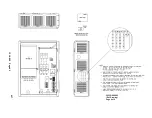
13-18-609 Page 28
4-3
Heat Exchanger Fan/Motor and Starter
- Two (2) radial fan/motor assemblies provide cooling air for the
heat exchangers and electronics box. These integrated units enable the AirSmart controller to match the
heat exchanger coolant needs in proportion to the package load level (specifically, the speed of the
compressor provides the proportioning control signal), thus saving fan power at reduced load operation.
The fans/motor combinations are designed to operate with 3ph-60Hz-460Vac electrical power
– the
necessary electrical wiring has been provided. For 3ph-60Hz-575Vac electrical power, step-down
transformers are included, within the electrical enclosure, to supply the proper voltage to the fan/motor
combinations.
Main Motor Ventilation Fan/Motor and Starter
– The combination axial fan/motor cools the main motor
by blowing fresh air over its body. The starter provides control for the fan motor only, as the latter
includes its own thermally-resettable, internal overload protection. These devices are designed to
operate with 3 ph-60 Hz-460 Vac electrical power
– the necessary electrical wiring has been provided.
Power Supply (24 VDC)
- This device supplies electrical power to the AirSmart controller and various
solenoid valves.
For Letter References A thru U below, see Figure 4-2, page 30.
Inlet (Poppet) Valve (B)
– This device is located at the intake flange of the compressor. During
compressor operation, the underside of the poppet is vented to atmosphere via a 3-way solenoid valve,
allowing the poppet to fall (open) and feed fresh air to the compressor inlet. During stopped operation
modes (e.g., commanded from keypad or initiated by protective shutdown), the 3-way solenoid valve
feeds an air signal to the underside of the poppet, forcing it upward (close) and block off the compressor
intake. This prevents trapped air and oil within the compressor from exiting through the inlet filter. See
SECTION 10, page 70 for further details.
Minimum Discharge Pressure/Check Valve (G) –
This device maintains a minimum pressure (80psig,
5.5 bar) within the air/oil reservoir, thus insuring (lubrication/cooling) oil injection flow into the
compressors. It also prevents the back flow of compressed air from the customer
’s piping back into the
compressor package when the compressor is not running. See SECTION 9, page 68 for further details.
The spring-loaded piston does not allow the discharge of compressed air from the air/oil reservoir until the
compressor builds up reservoir pressure to 80 psig. Beyond this pressure level, the valve remains fully
open.
Oil Mixing Valve (L)
– This device prevents the compressor from operating at a pressure and
temperature combination that condenses water vapor in the oil system. The servo-driven, 3-way, ball
valve mixes cooled and hot oil, prior to delivery to the oil filter and oil injection line, as commanded by an
algorithm residing in the package controller. See SECTION 5, page 47 for further details.
Pressure Relief Valve (Y)
– This device protects the pressure containing components of the compressor
package against high pressure exceeding 200 psig. See SECTION 11, page 72 for further details.
Pressure Regulator (BB)
– This device supplies the pneumatic signal to actuate the inlet (poppet) valve
(B). The regulator is adjusted to achieve an opening pressure of 80psig.
Inlet Feed Valve (C)
- This (three-way solenoid) device supplies/vents the required pneumatic signal to
actuate the inlet poppet valve. When energized, it vents the air signal from the inlet poppet valve,
allowing it to open and when de-energized, it supplies the air signal to the inlet poppet valve, forcing it
closed. Note that this pilot operated valve requires 37 to 40 psig pressure, at its intake port, to achieve its
normally open position (de-energized).
Ball Valve – Oil Drain (N) -
This device allows the drainage of the oil charge held in the reservoir during
oil change operation.
Содержание VS80A
Страница 31: ...13 18 609 Page 30 4 5 Figure 4 2 PIPING AND INSTRUMENTATION ILLUSTRATION 300CGE797 A Ref Drawing...
Страница 33: ...13 18 609 Page 32 4 7 300CGE546 04 Ref Drawing Page 2 of 4...
Страница 34: ...13 18 609 Page 33 4 8 300CGE546 04 Ref Drawing Page 3 of 4...
Страница 35: ...13 18 609 Page 34 4 9 300CGE546 04 Ref Drawing Page 4 of 4...
Страница 37: ...13 18 609 Page 36 4 11 301CGE546 B Ref Drawing Page 2 of 4...
Страница 38: ...13 18 609 Page 37 4 12 301CGE546 B Ref Drawing Page 3 of 4...
Страница 39: ...13 18 609 Page 38 4 13 301CGE546 B Ref Drawing Page 4 of 4...
Страница 41: ...13 18 609 Page 40 4 15 302CGE546 05 Ref Drawing Page 2 of 4...
Страница 42: ...13 18 609 Page 41 4 16 302CGE546 05 Ref Drawing Page 3 of 4...
Страница 43: ...13 18 609 Page 42 4 17 302CGE546 05 Ref Drawing Page 4 of 4...
Страница 45: ...13 18 609 Page 44 4 19 303CGE546 B Ref Drawing Page 2 of 4...
Страница 46: ...13 18 609 Page 45 4 20 303CGE546 B Ref Drawing Page 3 of 4...
Страница 47: ...13 18 609 Page 46 4 21 303CGE546 B Ref Drawing Page 4 of 4...
Страница 70: ...13 18 609 Page 69 9 2 Figure 9 1 MINIMUM DISCHARGE PRESSURE CHECK VALVE...
Страница 86: ...NOTES...
Страница 87: ...NOTES...
















































